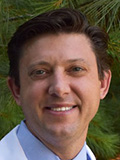The compelling story of regenerative aesthetics continues despite a global pan- demic and regulatory controversy surrounding some of its most promising avenues of research. Plagued by hype and the propensity to attract those trying to make a quick buck, the real story is how the amazing power of the body to regenerate itself is being captured and concentrated, catapulting aesthetic medicine forward.
|
Ryan Welter, MD, PhD CEO & Medical Director Regeneris Medical |
|
Joshua Crose, DO Director |
 Vincent McGinniss, DO Facial Plastic Surgeon Findlay, OH |
|
Allan Yang Wu, MD |
|
Douglas Wu, MD, PhD Dermatologist |
|
Kelly DeWolfe, ACNP Elevare MD Aesthetics and Skin Care |
|
Jason Emer, MD Dermatologist and Dermatologic Surgeon |
|
Diane I. Duncan, MD |
According to Ryan Welter, MD, PhD, CEO and medical director of Regeneris Medical (Boston, Mass.), and a pioneer in the use of platelet-rich plasma and adipose-derived stem cells in hair growth treatments, “Regenerative medicine of all kinds is at the forefront, without a doubt. As we learn more about cell-to-cell interactions and what drives them, we can better harness these interactions for therapeutic use without causing injury, which is what regenerative medicine is all about. When you think about it, non-invasive therapies such as radiofre- quency (RF) are a form of regenerative therapy.
“Patients are also demanding more nat- ural therapies that come from their own bodies or are derived from a naturally occurring source,” Dr. Welter continued. “The field is expanding exponentially, costs are coming down, and to some it can be overwhelming.”
“There is not an easily defined origin or evolutionary pathway for regenerative medicine versus aesthetics, as they have often moved in parallel, and have fed into each other throughout the decades,” said Joshua Crose, DO, director of Capitis Medical & Aesthetics (San Diego, Calif.).
“We tend to harken back to the 1930s with carboxy therapies in Europe for improved healing and a youthful glow,” Dr. Crose continued. “The basis for most of aesthetic medicine is the very principle of using the body to improve itself. We cause some sort of insult with the expectation that the body’s response will produce a positive result. Regenerative aesthetics is simply inducing the responses independent of the insult using compounds directly involved in these processes, or which activate them.”
Modern regenerative treatments work at the cellular level to unlock and activate existing processes present in our bodies. According to experts the most prominent among these are currently platelet-rich plasma (PRP), stem cells, growth factors, and most recently, exosomes. As such, the terms PRP, ‘stem cell’ and ‘exosome’ have been tacked onto various therapies to add flair to a therapy description – sometimes legitimately, sometimes not. Hence the strong December 2019 ruling by the FDA to limit exosomes to topical use, and continued overwatch by regulatory agencies to prevent the misuse of buzz words to promote unproven, even dangerous, therapies. “The problem with this is that it was an overreaction to a specific event, using a specific product that wasn’t named, followed by a blanket statement about a product that the FDA already cleared for experimental therapeutic use,” Dr. Crose explained.
Before and after treatment with nanoPRP Photos courtesy of Allan Yang Wu, MD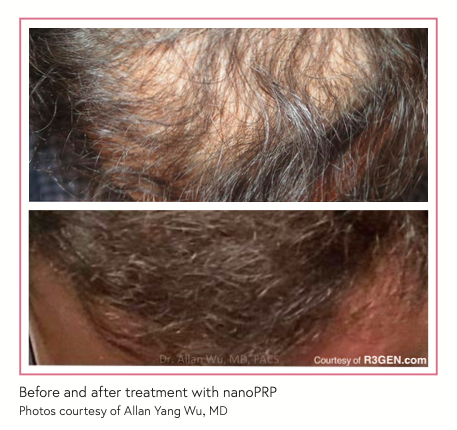
But with the pandemic forcing the focus of the FDA on other matters, there is currently more room to move within regenerative aesthetics. “What we are seeing is less backlash now, not a relaxation, but reduced attention unless harm is being done. This has opened the door for more development, and some regen- erative treatments have been tried for combating COVID-19 under emergency use rules, with promising results.”
“One of the challenges with something like PRP and the FDA is the lack of standardization, said Vincent McGinniss, DO, a facial plastic surgeon in Findlay, Ohio. “There are so many different kits and protocols so you cannot easily nail things down, but as a community we already have standardized protocols for maximizing safety during topical application and injection of other products, so we are using PRP safely.”
Another regulatory issue is the line between regulation of products and regulation of physician use and practices, according to Dr. Welter. “While we definitely need oversight and regulation of products, physician experts need a wide berth to maximally treat patients using the best means at their disposal. These conversations are still very open ended.”
The biggest issue right now is COVID- 19, according to Allan Yang Wu, MD, of Revive Wellness Center (Torrance, Calif.). “We are at a proverbial fork in the road due to the pandemic and as an industry we have to make sure we are not trans- mitting the virus, so we need to assure sterility and safety using autologous therapies and be sure there is docu- mentation that any allogenic products were properly tissue banked and will not carry the virus. This is largely theoretical and to my knowledge, there has been no case of transmission, but the threat from now on is ever present. However, the pandemic does not seem to have dis- suaded any of my clients, most of whom come in for autologous therapies.”
Currently rooted therapies include stem cells, growth factors and PRP, according to Douglas Wu, MD, PhD, who prac- tices at Cosmetic Laser Dermatology in San Diego, Calif., where he serves as director of research as well. “It is the topical use of these that represent the bulk of regenerative aesthetics today,” he said. “They include compounds that themselves upregulate the body’s natural regenerative processes, and which acti- vate existing cells to do similarly. We have made great leaps forward in stem cell research since I got my PhD in stem cell biology back in 2004. We are not just using stem cells, but growth factors, and other compounds derived from stem cells, in products designed to concen- trate and more effectively deliver them.”
“The caveat is whether or not therapies with these buzzwords actually have effective products associated with them, or if these products are used appropri- ately in a safe, effective manner,” Dr. D. Wu continued, “but there are powerful products out there that are safe and effective, alone or in combination with existing therapies to improve results and improve healing.”
Dr. A. Wu uses what he calls nanoPRP, where PRP is ultra-concentrated further to isolate autologous exosomes. “We use this for everything from scar treatment to skin lightening and hair regeneration. We are also deriving autologous exo- somes from the stromal vascular fraction, and performing microfat and nanofat grafting, which are becoming more prom- inent, mostly for long-term augmentation and scar resolution. The FDA issues with exosomes, especially autologous derived, are avoided by most of us because we perform the treatment in a same proce- dure setting and as a topical treatment without making broad claims,” he stated.
Named the Top Innovation in NEWBEAUTY Magazine’s 2020 Beauty Authority Awards, and winning the title of Top Medical Skincare Line from Aesthetic Everything, SoME® Skincare from Aesthetics Biomedical (Phoenix, Ariz.) is a rejuvenating topical anti-aging skincare product that uses a proprietary blend of ingredients combined (by physi- cians) with a patient’s PRP to provide a truly personalized cosmetic experience for patients. Until now, there has never been an autologous topical skincare product that uses the body’s own regen- erative properties to stimulate natural collagen and elastin, reduce the appear- ance of fine lines and wrinkles, enhance skin tone and texture, and improve discoloration, puffiness and darkness around the eyes.
“The science behind SoME is remarkable and my clients are always intrigued at how a topical product could have regen- erative properties,” said Kelly DeWolfe, ACNP, who practices with Michael DeWolfe, MD, at Elevare MD Aesthetics and Skin Care (Chicago, Ill.). “I have found that once a client uses SoME they never go back to traditional skincare products. They are so impressed by the overall health of their skin and notice improvement in their overall texture and brightness.”
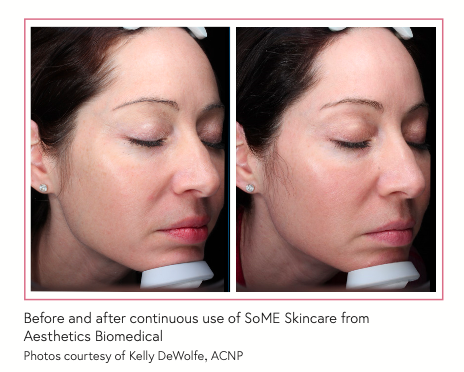
Harnessing the regenerative power of bone marrow stem cells, AnteAGE Growth Factor Solutions from AnteAGE, a division of Cellese, Inc. (Irvine, Calif.), are intended to be incorporated into RF and microneedling treatment protocols. The three varieties of carefully curated cytokines and growth factors trigger cell renewal and optimal cell performance for hair regrowth, skin brightening, overall skin health and anti-aging treatment. The primary function of these solutions is increased cell communication; reminding the cells how they once acted in their youth and getting them back on track.
The classic Growth Factor Solution has incredible healing potential for all anti- aging concerns. For hair regrowth it activates the WNT pathway to awaken dormant follicles and restart the growing pattern. For hyperpigmentation con- cerns, these growth factors combine with tranexamic acid and melanostatin to stop pigment formation from multiple pathways, creating an overall even and bright complexion. “ We believe that stem cells and growth factors are the key to anti-aging, cell renewal and reju- venation, and I believe AnteAGE MD offers the best technology and science in products available to consumers today for topical use,” said Beverly Hills-based dermatologist and dermatologic surgeon Jason Emer, MD (Beverly Hills, Calif.).
“That’s why I recommend use of AnteAGE MD products twice daily and I partnered with them to make the AERIFY microneedling system with a proprietary combination of human bone marrow stem cells, hyaluronic acid and nanopep- tides to improve wrinkles and pigmenta- tion, reverse cellular damage and prevent long-term aging,” Dr. Emer added.
While PRP, stem cell and growth factor therapies have become firmly estab- lished in the 21st century, the future is exosomes, in Dr. Crose’s opinion. “I have been doing research, first for aesthetic and then medical use, and we are seeing amazing things. That is why everyone is so excited about exosomes – the potential is huge,” he shared.
“Continued development of the currently popular products is ongoing, and we will continue to have a place for PRP, growth factors and stem cells, but overall, exosomes do a better job of the same thing,” Dr. Crose stated. “We are seeing it replace PRP for hair regrowth, even O-shots and P-shots. Exosomes go beyond the growth factor level to the genetic level of body cells themselves, affecting cellular communication and other processes directly. I see autologous allografts going by the wayside, except among plastic surgeons, because in general they are cumbersome, you have increased risk of contamination, and you get inconsistent results.”
“Exosomes are part of the cell membrane, which itself is designed to regulate the transmission between the cell and the environment,” Dr. Welter explained. “Exosomes are how cells deliver packages of growth factors and other compounds from one to another. When a cell receives the package, the contents are released into the cell. We can use exosomes to deliver specific compounds to cells, or to target specific cell types, and that is part of what we are working on in the community because it leads to more predictable, consistent results.
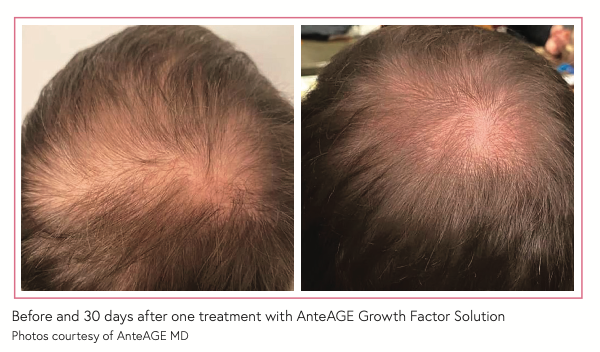
“The challenge with something like PRP for hair growth is the variability of the response because while PRP is safe, you cannot be sure of exactly what is happening from patient to patient, except that it will help,” Dr. Welter continued. “With exosomes we are increasing our ability to deliver a consistent set of compounds, targeted to maximize thera- peutic efficacy, with potential to yield better and more predictable results.”
Clinically proven BENEV Exosome Regenerative Complex + powered by ExoSCRTTM from BENEV Company, Inc. (Mission Viejo, Calif.) is an intensive dual action complex designed and developed in tandem with the fourth largest exo- some research company in the world, ExoCoBio (Seoul, South Korea). ExoSCRT is an innovative patented purification method of separating and refining 0.1% pure exosomes from stem cell condi- tioned media. The patented technologies and ingredients are clinically proven to quickly absorb into the skin and deliver the concentrated power of over 5 billion lyophilized exosomes, potent growth factors, peptides, coenzymes, minerals, amino acids, vitamins and irritation reducing agents to rejuvenate, and intensely moisturize, the skin and scalp. BENEV Exosome Regenerative Complex + powered by ExoSCRT is also paraben-free, steroid-free and hypoallergenic.
“Exosomes have potential applications across the field of medicine, said plastic surgeon Diane I. Duncan, MD, who prac- tices in Fort Collins, Colo. “Exosome Regenerative Complex + provides a topical way to integrate adipose derived exosomes and their benefits into all of my aesthetic treatments, providing safety, efficacy, affordability and utility, as well as shelf life.”
By themselves, these regenerative treatments are remarkable and sci- ence has only begun to understand their true potential, but one place they shine brightly is when used in com- bination with other proven therapies. “Given the principles of traditional aesthetic medicine – causing an injury to harness healing for an improved appearance – regenerative therapies are a natural addition because they stimulate the very processes we are otherwise counting on,” Dr. McGinniss explained. “Intuitively, this makes perfect sense, and we see improved outcomes with better healing. It can also be used intraoperatively to improve healing when applied during wound closure, which is less common, and in Europe they have products combining PRP with hyaluronic acid (HA) to synergistically improve short and long-term outcomes.”
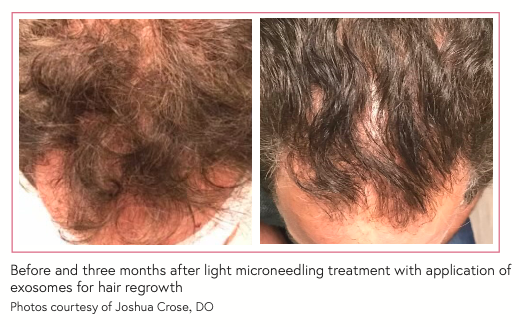
“A great example is hair follicle resto- ration, where we use exosomes plus light microneedling in the treatment area, with profound results,” Dr. Crose said. “The area heals quickly, and the exosomes go to work on the hair follicle. The hair growth cycle is admittedly long, but regrowth has been seen lasting two years, with retreatment being needed in only those cases with significant disease processes.”
Dr. D. Wu uses PRP and laser-assisted delivery of stem cell growth factors to improve the overall result seen with therapies such as laser resurfacing.
Similarly, Dr. McGinniss uses PRP with CO2 laser resurfacing. “The addition of PRP promotes angiogenesis, improves recollagenation and tissue regenera- tion, speeds healing, enhances wound strength and more. There is a lot of research backing up this combination and suggesting a synergistic effect.
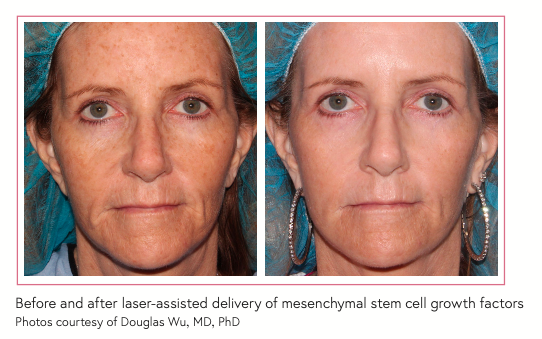
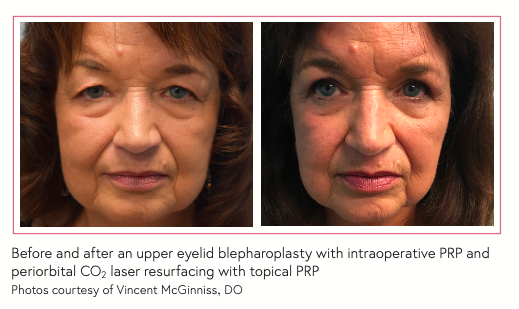
References:
Eisenstein M. Inside the stem-cell pharmaceutical factory. Nature 2020 Jun;582(7812):S16-S18.
Chang H, Sung C, Lin M. Efficacy of autologous platelet-rich plasma combined with ablative frac- tional carbon dioxide laser for acne scars: a system- atic review and meta-analysis. Aesthet Surg J 2019 Jun;39(7):NP279-NP287.
Hu S, Li Z, Lutz H, et al. Dermal exosomes containing miR-218-5p promote hair regeneration by regu- lating β-catenin signaling. Science Advances 2020 Jul;6(30). Accessible online at https://advances.sci- encemag.org/content/6/30/eaba1685/tab-pdf


